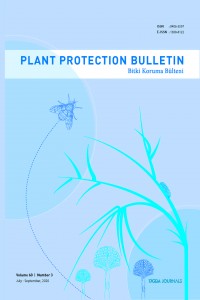Abstract
Safflower is a conspicuous energy crop might be used as a biofuel and raw material source for vegetable oil and animal feed sectors. It has a potential to reduce energy and oil dependency of Turkey reached to a high level due to its capacity. Weeds can cause yield loss because they compete with the crop for water, light, space, and nutrients in safflower. Weed control practices, therefore, should be made efficiently to gain high safflower yield. The aim of this study is to determine the efficacy of pendimethalin, s-metolachlor, and chlorsulfuron to control weeds and the response of safflower to them. The field experiments were conducted during 2017-2019 in Gölbaşı, Ankara, Turkey. Pendimethalin and s-metolachlor were applied to the soil surface before crop sowing at 675.0, 1012.5, 1350 and 2700, and 686.25, 915.0, 1372.5 and 2745.0 g active ingredient (ai) ha-1, respectively. Chlorsulfuron was treated at 3.75, 4.95, 5.625, 7.5 and 15.0 g ai ha-1 to the weeds when they were 2-4 true leaf stage. Responses of safflower to the herbicides and the efficacy of these herbicides on the weed were visually evaluated 14 and 28 days after treatment (DAT) and before the harvest. Pendimethalin caused very slight crop injury, and the symptoms were disappeared at 28 DAT in 2017, but same symptoms were not observed in 2018. The crop injury caused by chlorsulfuron was transient when it was applied lower than at 5.625 g ai ha-1; however, chlorsulfuron at 7.5 and 15 g ai ha-1 injured persistently safflower plants. Pendimethalin provided moderate control on wild mustard and redroot pigweed at 1350 g ai ha-1 while s-metolachlor at 1372.5 g ai ha-1 sufficiently controlled redroot pigweeds, but not wild mustard. Weed control with chlorsulfuron at higher than 4.95 g ai ha-1 was good compared to lower rates.
Keywords
Supporting Institution
General Directorate of Agricultural Research and Policy
Project Number
TAGEM/BSAD/B/18/A2/P4/490
References
- Dr. Sait ERTÜRK Dr. Ayşe ÖZDEM
Abstract
Aspir, biyoyakıt ve bitkisel yağ ile hayvan yemi sektörleri için hammadde kaynağı olarak kullanılabilecek dikkat çekici bir enerji bitkisidir. Bitki, bu kapasitesi sayesinde Türkiye'nin yüksek seviyelere ulaşan enerji ve petrole bağımlılığını azaltma potansiyeline sahiptir. Aspirdeki yabancı otlar ürünle su, ışık, alan ve besinler için rekabet ettikleri için verim kaybına neden olabilirler. Bu nedenle, aspirde yüksek verim elde etmek için yabancı ot kontrolü uygulamaları etkili bir şekilde yapılmalıdır. Bu çalışmanın amacı pendimethalin, s-metolachlor ve chlorsulfuronun yabancı otları kontrol etme etkisini ve aspirin bu herbisitlere olan tepkisini belirlemektir. Tarla denemeleri 2017-2019 yılları arasında Gölbaşı, Ankara, Türkiye'de yürütülmüştür. Pendimethalin tohum ekiminden önce 675.0, 1012.5, 1350 ve 2700 g aktif madde ha-1 dozlarında, s-metolachlor ise 686.25, 915.0, 1372.5 ve 2745.0 g aktif madde ha-1 dozlarında uygulanmıştır. Chlorsulfuron, 2-4 gerçek yaprak döneminde olan yabancı otlara 3.75, 4.95, 5.625, 7.5 ve 15.0 g aktif madde ha-1 dozlarında tatbik edilmiştir. Aspirin herbisitlere tepkileri ve bu herbisitlerin yabancı otlar üzerindeki etkisi, uygulamadan 14 ve 28 gün sonra ve hasattan önce gözleme dayalı değerlendirme yöntemine göre değerlendirilmiştir. Pendimethalin 2017 yılında hafif düzeyde fitotoksisiteye neden olmuş ve uygulamadan 28 gün sonra bu belirtiler kaybolmuş; ancak benzer fitotoksisite belirtileri 2018'de gözlenmemiştir. Chlorsulfuronun neden olduğu fitotoksisite, 5.625 g aktif madde ha-1'den daha düşük dozlarda uygulandığında geçici iken herbisit 7.5 ve 15 g aktif madde ha-1'de uygulandığında kalıcı olmuştur. Pendimethalin, 1350 g aktif madde ha-1'de uygulandığında yabani hardal ve kırmızı köklü tilki kuyruğunda orta derecede kontrol sağlarken, s-metolachlor 1372.5 g aktif madde ha-1'de kırmızı köklü tilki kuyruğunu etkili şekilde kontrol etmiş ancak yabani hardalı kontrol edememiştir. Chlorsulfuron ile yabancı ot kontrolü herbisitin 4.95 g aktif madde ha-1'den yüksek dozlarında düşük dozlara kıyasla daha iyi bulunmuştur.
Keywords
Project Number
TAGEM/BSAD/B/18/A2/P4/490
References
- Dr. Sait ERTÜRK Dr. Ayşe ÖZDEM
Details
| Primary Language | English |
|---|---|
| Journal Section | Makaleler |
| Authors | |
| Project Number | TAGEM/BSAD/B/18/A2/P4/490 |
| Publication Date | September 30, 2020 |
| Submission Date | March 25, 2020 |
| Acceptance Date | April 28, 2020 |
| Published in Issue | Year 2020 Volume: 60 Issue: 3 |


